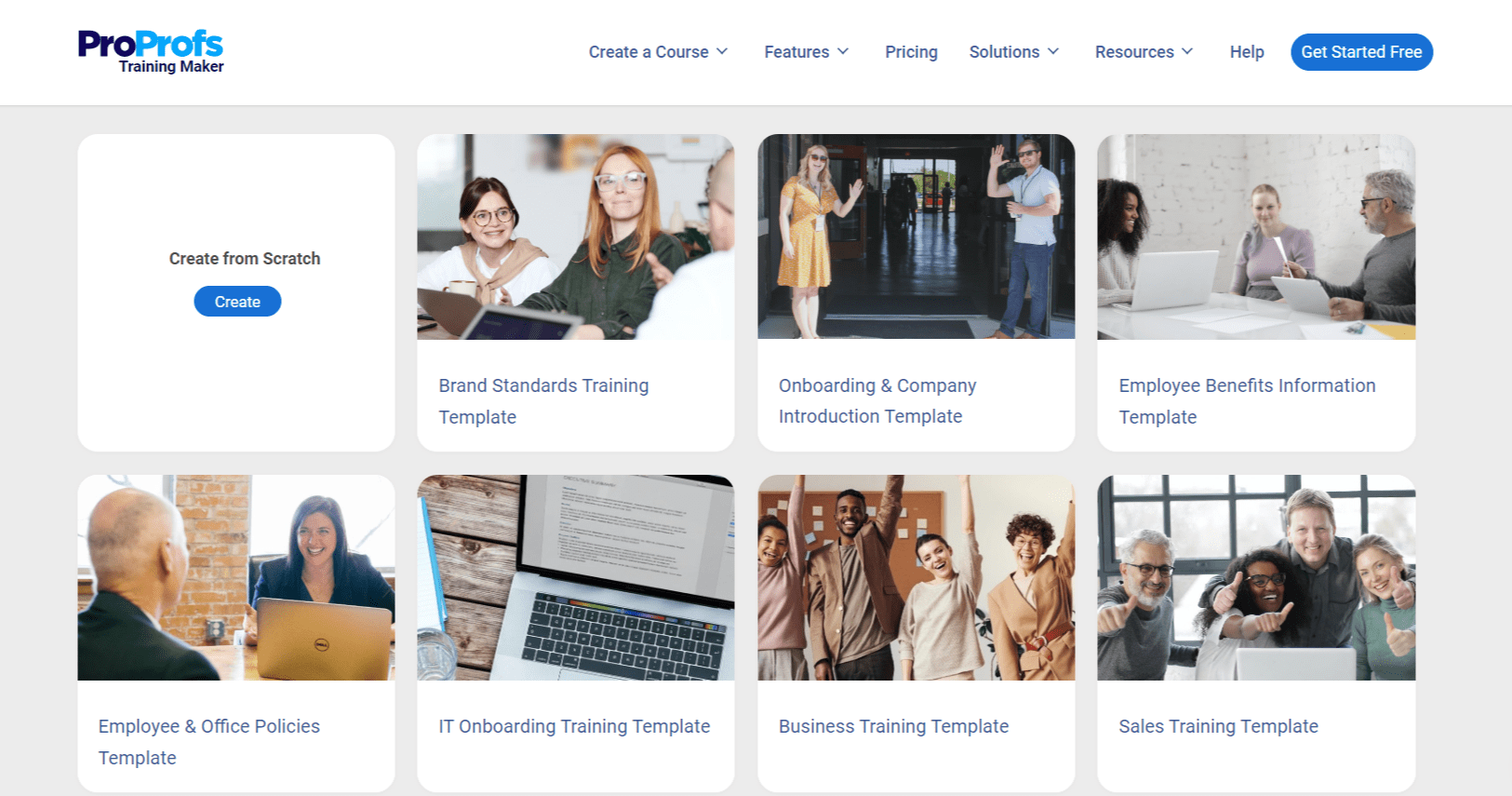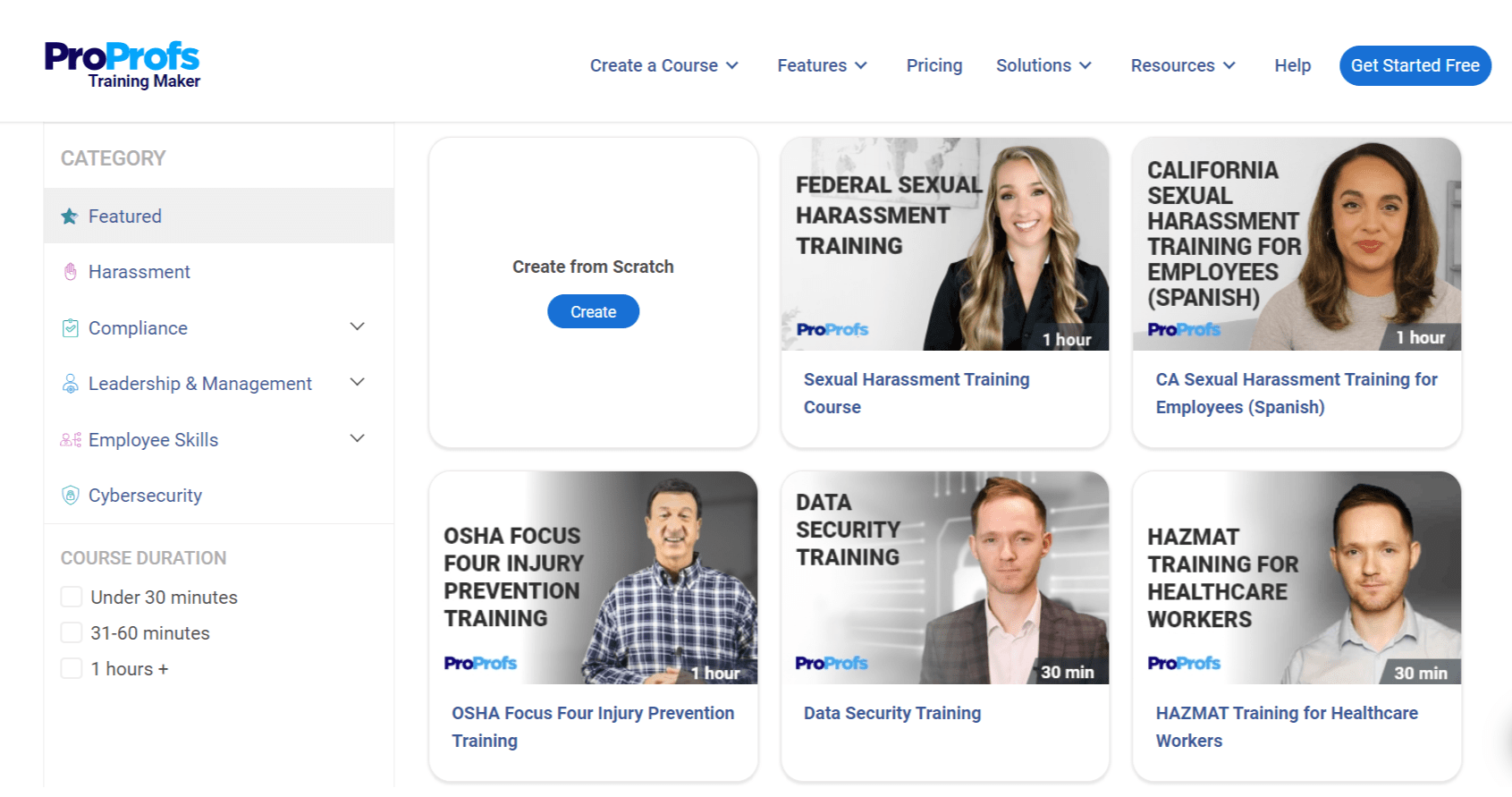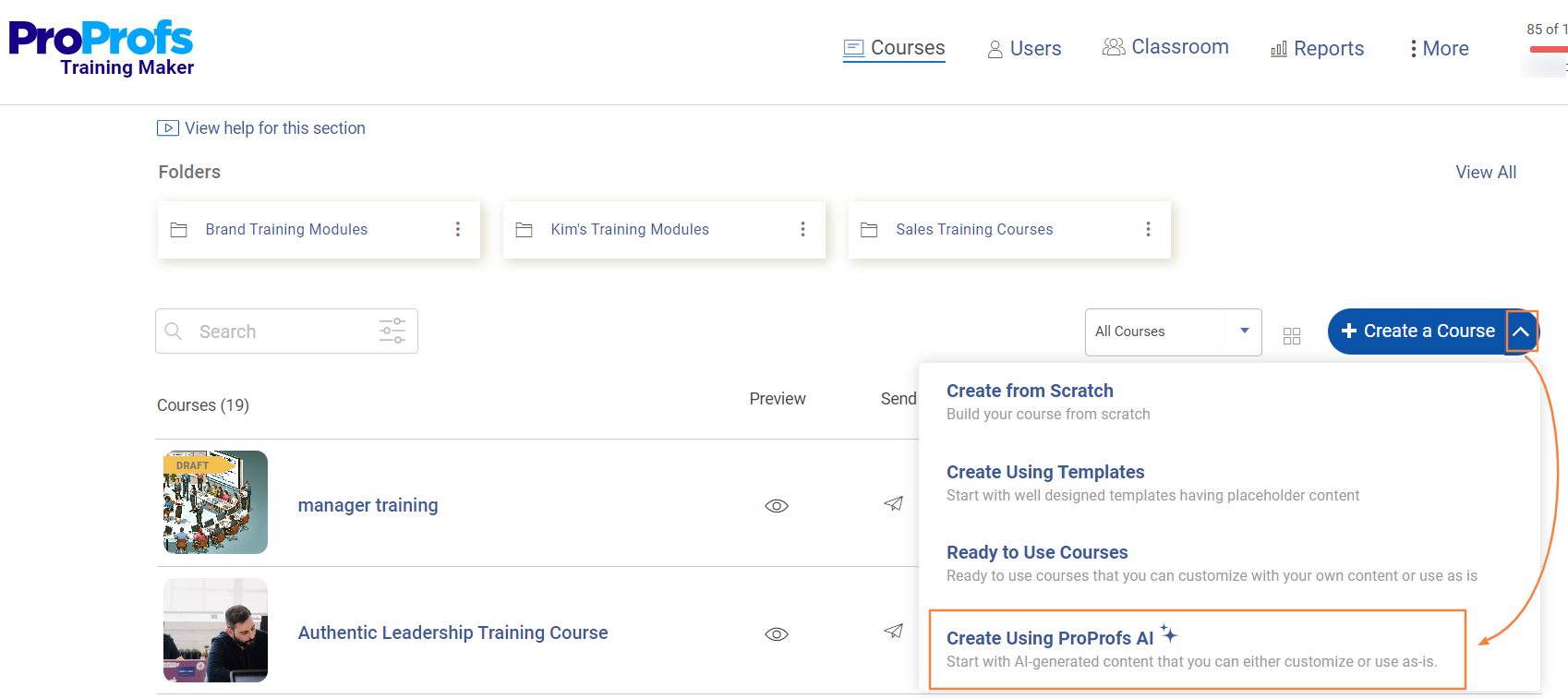Everybody learns at a different pace. If given the choice, you probably would also do things at your own pace instead of conforming to a generalized or rigid schedule.
Self-paced learning offers individuals a chance to learn things in their own time, leading to a massive boom in the market of self-paced training courses. This is further attested by the fact that the self-paced eLearning market is projected to hit $65.41 billion by the end of 2025.

In this blog, let’s explore self-paced learning, its advantages, potential drawbacks, how to create self-paced courses, and some real-life examples.
What is Self-Paced Learning?
Self-paced learning is a flexible method of learning where learners can control the timing and speed of the course materials, lessons, or activities they take at their convenience rather than following a generalized timetable.
Usually, when we speak of training modules, what comes to mind are deadlines, scheduled quizzes, and fixed assignment dates. Self-paced learning flips that familiar script. It empowers learners to progress through material at their own speed, revisiting tricky concepts or speeding through familiar ones as needed.
This adaptable approach accommodates diverse learning styles and schedules, which makes it ideal for busy professionals, those with varying levels of prior knowledge, or anyone who simply prefers to learn at their own rhythm.
But how exactly does it work? That’s what we will explore in the next section.
How Does Self-Paced Learning Work?
Think of it this way: instead of a classroom with a set schedule, learners have a vast, digital library of resources at their fingertips that they can access anytime.
The core message of this learning method is: “Want to watch a video tutorial at 2 AM? Go for it. Prefer to listen to a podcast during your commute? No problem. Need to review a specific chapter five times before it clicks? That’s perfectly fine.”
Self-paced learning removes the constraints of traditional learning environments and empowers trainees to chart their own courses.
This often involves:
- Digital resources: Online courses, videos, eBooks, downloadable guides, and interactive exercises are common formats.
- Progress tracking: Many platforms allow you to track progress, mark completed modules, and even earn badges or certificates.
- Flexibility: Learn from anywhere, at any time, and on any device.
With all that it offers, self-paced learning must have some tangible benefits. Yes, let’s explore what those can be.
Benefits of Self-Paced Learning
Here are some key benefits for both learners and course creators.
1. Progress at an Individual Pace
Self-paced learning allows learners to move through content at their own speed, accommodating different learning styles and life circumstances. Whether it’s a parent balancing childcare, a full-time worker squeezing in lessons, or someone with a learning difficulty requiring more time, this approach ensures everyone can succeed without feeling rushed. Similarly, faster learners can avoid the frustration of waiting for others and move quickly through the material.
2. Self-Regulation & Time Management Skills
Without fixed deadlines, self-paced learning encourages learners to take responsibility for their progress. This fosters valuable skills like self-discipline, time management, and autonomy—traits that not only benefit learning but are highly sought after in professional environments. For course creators, this shift also reduces the need for constant intervention, as learners manage their own schedules effectively.
3. Reduced Pressure and Anxiety
Studies reveal that 25–40% of students in the U.S. experience test anxiety, which can carry over into their professional lives. Self-paced learning alleviates this pressure by letting learners complete assessments when they’re ready, helping them perform better without the added stress of strict deadlines or group settings.
4. Larger Enrollments
Self-paced learning allows course creators to reach a wider audience. Without the constraints of scheduled sessions, more learners are motivated to enroll in a program. For organizations, this means offering training to larger groups efficiently and without needing multiple sessions.
5. Cost-Effectiveness
By eliminating the need for live instructors and recurring sessions, self-paced learning significantly reduces costs. Companies can scale their training efforts while saving on expenses for instructional resources, travel, or venue costs. In fact, a study by IBM found that e-learning programs can cut training costs by 40%, making self-paced learning an ideal choice for organizations.
Watch how KDD (Kuwaiti Danish Dairy Company) has reduced training costs with online learning:
Disadvantages of Self-Paced Learning
While self-paced learning has numerous benefits, it also comes with some challenges that can impact its effectiveness for learners and course creators.
1. Limited Collaboration
Unlike traditional classroom settings or cohort-based learning, self-paced learning often lacks opportunities for group work and peer interaction. Learners typically progress independently, which can make the experience isolating.
Without collaboration, trainees miss out on valuable perspectives, group problem-solving, and the sense of camaraderie that comes with shared learning experiences. This can hinder the development of teamwork skills and limit the opportunity to learn from others’ insights.
2. Reduced Structure
The lack of a fixed schedule is both a strength and a drawback of self-paced learning. For some learners, the absence of structured timelines can make it difficult to stay disciplined and focused.
Unlike cohort-based learning, where learners follow a defined path with set deadlines, self-paced programs often leave learners to create their own schedules. This freedom can be overwhelming, particularly for those who struggle with time management or procrastination, leading to delays or incomplete learning journeys.
3. Fewer Networking Opportunities
In traditional or cohort-based courses, learners often connect with peers and instructors, forming professional relationships that can extend beyond the classroom. Self-paced learning, on the other hand, limits these interactions because participants are typically not learning simultaneously.
The lack of a shared experience can make it harder for learners to build connections, exchange ideas, or collaborate on future projects, which is often an added value of traditional learning environments.
4. Motivation Challenges
One of the most significant challenges of self-paced learning is maintaining learner motivation over time. Without external motivators like mandatory attendance, scheduled deadlines, or the presence of peers, learners may find it difficult to stay engaged.
The risk of procrastination or losing interest increases, particularly for lengthy or complex courses. This lack of accountability can result in lower completion rates compared to more structured learning formats.
Get Free eLearning Authoring Software — All Features, Forever.
We've helped 567 companies train 200,000+ employees. Create courses in under a minute with our AI LMS or use 200+ ready-made courses on compliance, harassment, DEI, onboarding, and more!
How to Create a Self-Paced Learning Course?
Creating a self-paced learning program is easier than most people think. With the right approach, you can design engaging, flexible, and effective courses.
Here’s a quick guide tailored for course creators, with ProProfs Training Maker as an example.
Create your forever free account with ProProfs. Get Started!
1. Start With a Course Template
Kick off by choosing a professionally designed template that aligns with your training objectives—be it compliance, onboarding, or soft skills. Templates offer a structured foundation, complete with predefined sections for policies, quizzes, or media. For instance, an onboarding template might include modules on company culture, job expectations, and an introduction quiz.

2. Upload Existing Material or Start Fresh
Easily integrate your current training materials, such as PDFs, presentations, or videos, by uploading them directly into the platform. Alternatively, you can leverage a library of customizable & ready-to-use courses taught by experts.

Similarly, you can also use ProProfs AI to generate outlines and dynamic courses tailored to your topic.

You can create such digital courses for the following training types:
- Harassment
- Compliance
- Leadership & Management
- Employee Skills
- Cybersecurity
- Health & Wellness
- Or any other topic of your choice
3. Personalize With Branding & Multimedia
Enhance learner engagement by adding interactive elements like videos, voiceovers, and quizzes. Customize your course with logo, brand colors, and themes to ensure a consistent and professional appearance. With white labeling, you can make the course feel like an in-house creation.
4. Include Quizzes & Assessments
Strategically placed quizzes are a great way to measure learner understanding and retention. Use a mix of question types, such as multiple-choice and scenario-based questions, to reinforce key concepts and address real-world challenges. You can create your own questions to match specific course goals or use our AI Quiz Maker to speed up the process.
5. Assign Roles and Manage Groups
Streamline administration by assigning roles like instructors or admins to oversee learner groups, track progress, and generate reports. You can customize permissions and limit information access to ensure your learners’ data remains safe.
6. Publish and Share Your Course
Distribute your course effortlessly through email, embedded links, QR codes, or social media. Set up permissions to control access to course materials. Allows learners to pause their learning sessions and return to them later without losing progress.
7. Track Progress With Reports
Use the built-in reporting tools to monitor who completed the course, their quiz scores, and time spent on modules. Detailed reports provide insights into learner performance and help identify areas needing improvement.
8. Gather Feedback and Refine
Add surveys to your courses to collect feedback on what’s working and what needs adjustment. Use built-in survey templates to save time and analyze responses to know what’s working and where you could improve.
By following these steps, you’ll create self-paced learning experiences that not only meet the needs of diverse learners but also help them thrive in an independent learning environment.
However, if you are looking for a general overview of how to create self-paced learning courses, here are the key steps you need to follow:
- Define Your Audience and Objectives: Identify your learners’ needs and set clear, measurable learning goals.
- Organize Your Content: Break the course into structured modules with a logical progression to ensure clarity and consistency.
- Incorporate Multimedia: Use videos, presentations, infographics, and interactive quizzes to engage learners and cater to diverse learning styles.
- Provide Clear Guidance: Include instructions, supplemental resources, and optional milestones to keep learners on track without overwhelming them.
- Assess Learning: Add checkpoints like quizzes or assignments to reinforce understanding and measure progress.
- Gather Feedback: Use surveys or feedback forms to understand what’s working and where improvements are needed.
- Ensure Accessibility: Optimize your course for various devices and platforms, allowing learners to access content anytime, anywhere.
Challenges of Self-Paced Learning & How to Overcome Them
Self-paced learning is highly flexible but it comes with its share of challenges. Here are some common hurdles and practical strategies to address them:
| Challenge | Description | Solution |
|---|---|---|
| Lack of Motivation | Learners may struggle to stay engaged without external deadlines or social pressure. | Add engaging content like gamified quizzes, set optional milestones, and send automated reminders. |
| Limited Collaboration | The independent nature of self-paced learning can lead to isolation and fewer networking opportunities. | Incorporate discussion forums, peer reviews, or asynchronous group activities to foster interaction. |
| Difficulty Managing Time | Learners may face challenges in organizing their study schedules effectively. | Provide suggested timelines, clear goals for each module, and tools like checklists to help learners stay on track. |
| Reduced Accountability | With no real-time instructor monitoring, learners might deprioritize a course. | Use progress trackers, completion badges, or regular progress emails to instill a sense of accountability. |
| Technical Barriers | Accessing or navigating online courses can sometimes be overwhelming. | Ensure the course is user-friendly, optimized for all devices, and includes technical support. |
Despite these challenges, self-paced learning has become popular because its pros far outweigh the cons. We will see a testament to that in the next section.
Self-Paced Learning Examples
Ever wondered just how prevalent self-paced learning is? Chances are, you’ve already experienced it firsthand. Here are some familiar examples:
1. Online Courses
Platforms like Coursera, Udemy, and edX have become incredibly popular, offering a huge range of courses on almost any topic imaginable. These courses typically include video lectures by industry experts, interactive exercises to reinforce key concepts, downloadable resources for offline access, and quizzes or assignments to help you assess your understanding.
The best part is, you can learn at your own speed, revisit challenging modules as needed, and fit your studies around your busy schedule.
2. Corporate Training Programs
Many companies now use self-paced learning for onboarding new employees, delivering compliance training, and providing professional development opportunities. These programs often utilize a variety of formats, such as interactive modules, video tutorials, and downloadable guides, to make learning engaging and convenient.
Employees can access these resources at their own pace, ensuring they have ample time to absorb the material and apply it to their roles.
3. MOOCs (Massive Open Online Courses)
MOOCs provide open access to high-quality learning experiences for anyone with an internet connection. These courses typically include a combination of video lectures, readings, assignments, and interactive discussion forums where learners can engage with peers and instructors from around the world.
This collaborative learning environment, coupled with the self-paced structure, makes MOOCs an appealing option for those seeking a flexible and engaging learning experience.
4. Textbooks and Workbooks
While technology has transformed the educational landscape, traditional learning resources like textbooks and workbooks remain valuable tools for self-paced learning. They offer a structured approach, allowing individuals to progress through concepts at their own speed, revisit challenging sections, and reinforce their understanding through practice exercises.
5. Language Learning Apps
Learning a new language has never been easier, thanks to self-paced language learning apps like Duolingo, Babbel, and Rosetta Stone. These apps utilize gamification, personalized learning paths, and interactive exercises to make language acquisition engaging and accessible. Learners can progress through lessons at their own speed, focusing on areas where they need extra practice.
Some specific corporate examples where self-paced learning has been used are:
A. Amazon
Amazon’s Career Choice Program is all about giving employees the power to learn new things and grow their careers. They offer a bunch of self-paced courses in fields like IT, healthcare, and logistics.
Employees can pick from tons of online courses and certifications, and Amazon even helps pay for them! It’s super flexible, so workers can learn on their own time and advance in their current roles or even switch to something new. Talk about a win-win!
B. IBM
IBM’s Think Academy is a great example of how self-paced learning works in the tech world. It’s a platform where employees can explore cool new technologies like AI, blockchain, and quantum computing – all at their own speed.
They’ve got gamified lessons, video tutorials, and even ways to get certified. Employees can learn whenever they want, which is perfect for busy schedules. This helps IBM stay ahead of the game and keep their skills sharp.
C. Walmart
Walmart’s Pathways Program is designed for its frontline workers. It’s a self-paced way for employees to learn important retail skills like customer service, inventory management, and workplace safety.
They use mobile-friendly video lessons and quizzes so employees can learn on the go and at their own pace. This speeds up onboarding, helps employees develop their skills, and even improves employee retention. It’s all about giving employees the freedom to learn in a way that works for them.
Real-Life Success Story
Challenge
A global disaster response services provider sought to equip its employees and clients with the knowledge and skills to effectively plan, train, and respond to crises. Their goal was to transform a traditional classroom training program into an engaging, digital learning experience. However, they faced the challenge of presenting dry and sensitive content in an interactive manner that could resonate with an international audience.
Solution
To address this, a digitized training program was developed, enabling learners to absorb information at their own pace while mastering the principles of aviation crisis management. Key principles were distilled into concise learning modules by collaborating closely with subject matter experts. These were seamlessly connected into a structured learning path, enriched with Performance Support Tools (PSTs) for ongoing guidance.
Results
The revamped training program delivered significant benefits:
- Learners responded positively to the digital format, appreciating the innovative approach.
- Values and behaviors were demonstrated more effectively compared to the traditional in-person training, thanks to relatable content.
- Self-paced learning fostered a deeper understanding of processes and better application in real-life scenarios.
- The importance of adhering to compliance protocols was successfully reinforced.
Get Free eLearning Authoring Software — All Features, Forever.
We've helped 567 companies train 200,000+ employees. Create courses in under a minute with our AI LMS or use 200+ ready-made courses on compliance, harassment, DEI, onboarding, and more!
Ready to Implement Self-Paced Learning?
Self-paced learning is reshaping the way we approach education and skill-building. It empowers learners to take control of their progress while giving organizations the tools to provide flexible and impactful training.
As seen in real-world examples, this method is not just a trend but a practical solution for modern learning needs. Whether it’s for personal growth or workforce development, self-paced learning is a step forward in making learning accessible, efficient, and tailored to individual needs.
So why wait any longer? Start building flexible, learner-focused online programs today!
 Tips
Tips
We’d love to hear your tips & suggestions on this article!
Get Free eLearning Authoring Software — All Features, Forever.
We've helped 567 companies train 200,000+ employees. Create courses in under a minute with our AI LMS or use 200+ ready-made courses on compliance, harassment, DEI, onboarding, and more!

 We'd love your feedback!
We'd love your feedback! Thanks for your feedback!
Thanks for your feedback!







